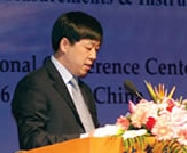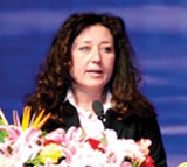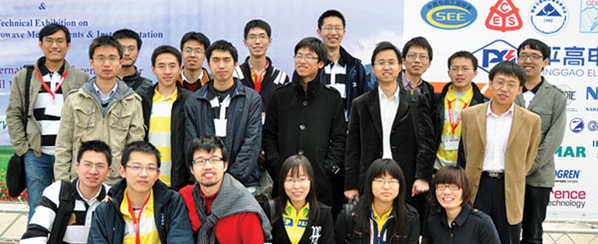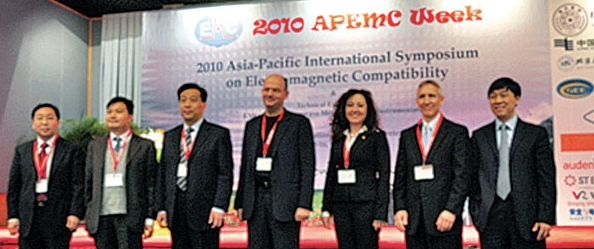|
The
2010 Asia-Pacific International Symposium on Electromagnetic
Compatibility (APEMC) was held from April 12 to 16, 2010 at the Beijing
International Convention Center with the theme of “EMC Harmonizes the
World.” This event addressed the needs of a rapidly rising EMC community
in the Asia-Pacific region while promoting excellence and warm
relationships amongst the EMC community. The 2010 APEMC Symposium was
lead by the president, Professor Jinliang He, an IEEE Fellow from
Tsinghua University in Beijing. Professor He also received the IEEE EMC
Society’s Technical Achievement Award at the recent 2010 IEEE
International Symposium on EMC held in Fort Lauderdale, Florida. With the
fabulous Chinese organizing team, APEMC 2010 was a resounding success.
APEMC 2010 has further strengthened the Asia-Pacific EMC foundation and
extended its influence worldwide. The Symposium has been the largest EMC
event in China, which provided an opportunity to bridge the EMC community
in China and the World.
Over 700 delegates from 43 countries and regions, including 300 foreign
delegates outside Mainland China, attended this event, which makes the
APEMC a truly global conference. In addition, 68 exhibitors were
co-located with the APEMC 2010.
The
opening ceremony took place in the morning of April 13, attended by over
700 delegates and invited guests. The Symposium was officially declared
“open” by the Guest-of-Honor, Professor Zhuan Li-jun, Deputy President of
Tsinghua University. Professor Jinliang He gave a welcome address as did the
President of the IEEE EMC Society, Professor Francesca Maradei. The
General Chair, Professor Erping Li, outlined the APEMC history and
future, and the Technical Program Chair, Professor Todd Hubing, outlined
the technical program of the Symposium.
The
Symposium committee invited the former President of the IEEE
Electromagnetic Compatibility Society, Professor Todd Hubing of Clemson
University in the USA, to be the Chairman of the Technical Program
Committee (TPC), and another 67 global well-known experts to be TPC
members.
|


|
The
general organization of the Symposium had a focus on high quality technical
papers by speakers from all over the world. A total of 578 papers were
received; of these, 432 papers were selected for oral and poster
presentations. Spanning over three days (April 13–15), the Symposium
offered a total of 61 well attended oral technical sessions, based on six
parallel technical tracks and six Open Forum poster sessions. On top of
these high quality technical sessions, there were four plenary talks by
renowned experts on the morning of April 13 and 14. The first was given by
Dr. Wang Jing, from the China TD Forum, who spoke on “Opportunities and
Challenges of TD-SCDMA and TD-LTE,” followed by Professor Niels Kuster,
from the Swiss Federal Institute of Technology Zurich, on “The Past,
Present and Future of SAR Assessments and Human Safety of Electromagnetic
Radiation”, Dr. Bruce Archambeault, from IBM, on “The Future of EMC
Requirements, Design and Tools”, and Professor Wang Zhihua, from Tsinghua
University, China, on “Industry Status and Technology Trends of Integrated
Circuit Design in China.”
In
conjunction with the technical sessions, a total of 11 workshops and seven
tutorials sessions were conducted on Monday, April 12 and Friday, April 16,
which were organized by 44 internationally renowned EMC specialists.
Eighteen
Special Sessions were organized by famous EMC experts, including “EMC Test
and Measurement” by Dr. Wen Lie Liang of QuieTek Corporation and Professor
Han-Nien Lin of Feng Chia University, Chinese Taipei; “Recent Progress in
EMC Numerical Modeling” by Dr. Qingsheng ZENG of the Communications
Research Centre Canada; “EMC Computer Modeling and Simulation” by Professor
Junwei Lu of Griffith University, Australia; “Recent Progress in Modeling
and Simulation for EMC” by Professor Francesca Maradei of Sapienza
University of Rome, Italy: “Numerical Modeling for Complex EMC Systems” by
Professor Ji Chen of the University of Houston, USA, and Dr. Bruce
Archambeault of IBM, USA; “Effects and Protection of Intentional
Electromagnetic Interference” by Dr. William Radasky of Metatech
Corporation, Goleta, California, USA and Professor Wen-Yan Yin of Zhejiang
University, China; “EMC in Mobile Phones” by Dr. Huang Jingyu of Nokia
Mobile Phone Device R&D Beijing, China; “Automotive EMC – EMC Solutions
for New Automotive Technologies” by Professor Stephan Frei of the
Technische Universität Dortmund, Germany; “Modeling and Analysis of Packaging
Structures for EM Reliability” by Dr. Ivan Ndip of Fraunhofer IZM, Germany;
“Biomedical EMC” by Dr. C.-K. Chou of Motorola Inc. USA, Professor Ji Chen
of the University of Houston, USA, and Professors Osamu Fujiwara and
Jianqing Wang of the Nagoya Institute of Technology, Japan; “ESD and
Transients” by Professors David Pommerenke of the Missouri University of
Science and Technology, USA, Osamu Fujiwara of the Nagoya Institute of
Technology, Japan, and Dr. Ken Kawamata of the Hachinohe Institute of Technology,
Japan; “Signal and Power Integrity for Multi-Gbps Digital Circuits” by
Professor Jun Fan of the Missouri University of Science and Technology,
USA, Professor Antonio Orlandi of the University of L’Aquila, Italy, and
Dr. Bill Chen of Cisco, USA; “EMC Research and Development” in Taiwan by
Professor Ching-Wen Hsue of the National Taiwan University of Science and
Technology, Chinese Taipei; “Overview of EMC in Europe” by Professor
Marcello D’Amore of the University of Rome La Sapienza, Italy; “Model Validation
for EMC Simulations” by Professor Franz Schlagenhaufer of the University of
Western Australia, Australia; “EMC and Solution of Power Electronics” by
Professor Zhengming Zhao of Tsinghua University, China; “Electromagnetic
Environment of Power System” by Professor Xiang Cui of North China Electric
Power University, China, Dr. W. H. Siew of University of Strathclyde, UK,
and Professor A.P.J. van Deursen of Eindhoven University of Technology,
Netherlands; and “Advances in Radiated Measurements” by Zhong Chen of
ETS-Lindgren, USA. One Industry Forum “Emission Measurements – Novel and
Alternative Methods” was organized by Dr. Stephan Braun of GAUSS
Instruments GmbH, Germany. Two topical meetings were presented, including a
“Topical Meeting on Lightning Protection” by Professor Vladimir A. Rakov of
the University of Florida, USA, Dr. S. Yokoyama of the Central Research
Institute of Electric Power Industry (CRIEP), Japan, and Professor Farhad
Rachidi of Swiss Federal Institute of Technology – Lausanne, Switzerland.
The second presentation was “Topical Meeting on Advanced Research in EMC of
ICs” by Dr. Sonia Ben Dhia of INSA de Toulouse, France, and Dr. Thomas
Steinecke of Infineon, France.

The
Symposium dinner banquet took place on April 14 at the Beijing
International Convention Center. The Best Symposium Paper and Best
Symposium Student Papers were presented at the dinner, and a two-hour
Chinese traditional performance was presented. The performance included
three different Chinese folk dances, Jiangnan opera, magic, acrobatics,
folk music, Kung Fu, Sichuang opera-changing faces, and Peking Opera. Every
attendee deeply enjoyed the performances.
The
Best Symposium Paper Award, selected by the Symposium Paper Committee
chaired by Professor Todd Hubing, was given to Takahiro Yoshida, Hiroshi
Yoshihara, Kentaro Kawasaki, and Noriaki Masui from the Tokyo University of
Science, Japan for their paper entitled “Effect of the Shapes of Metal
Electrodes on ESD Current and Radiation Noise.”
Three
Best Student Papers were selected by the Student Papers Committee chaired
by Professor Erping Li. Besides their oral presentations, the students were
required to present their papers in the poster session. The first prize was
awarded to Ashok Narayanan from Carleton University, Ottawa, Ontario,
Canada, for his paper “Fast EMI Analysis of Massively Coupled Interconnects
with Long Delay”; the second prize was awarded to Anqi Hu from the Naval
University of Engineering Wuhan, China for his paper “Common-Mode
Interference Suppressor for Chopper Circuit Based on Negative Capacitance:
Applications and Improvements”; the third prize went to Fayu Wan of Avenue
Galilée, Saint Etienne du Rouvray, France for his paper “Study of
Susceptibility of an MCU Control System in the Automotive Field.”



The
IEEE EMC Society, together with several other cooperating Societies,
provided technical co-sponsorship. The Symposium also received sponsorship
from China EPRI, China Southern Power Grid Technology Research Center (CSG
TRC), China NSFC, Henan Pinggao Electric Co., AR RF/MICROWAVE INSTRUMENTATION,
China State Grid Electric Power Research Institute, Lightning Protection
Center of Guangdong Province, Chinese Society for Electrical Engineering
(CSEE), and the IEEE Singapore EMC Chapter.
The
next Asia-Pacific EMC Symposium will take place in 2011 in Cheju, Korea. On
behalf of the organising committee, we invite everyone to attend.
|